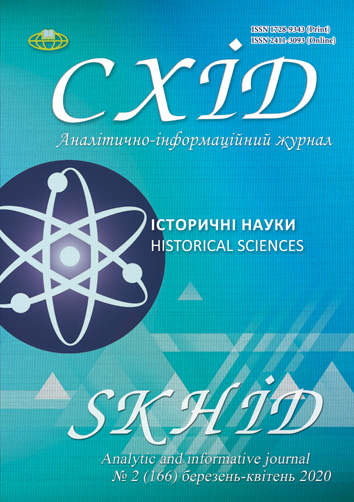Igor Volk: “Where aviation is, the country rises”
DOI:
https://doi.org/10.21847/1728-9343.2020.2(166).201361Keywords:
Aviation, astronaut Igor Volk, test pilot Igor Volk, born in UkraineAbstract
At the very beginning of cosmonautics, Ukraine distinguished itself as a space state. In the field of space conquest, we had significant achievements: the Ukrainian was in outer space, the Ukrainians participated in international programs, produced space transport. Among the astronauts of the USSR, many who were born in Ukraine and made a significant contribution to the development of the world astronautics. Such personalities include the 58th cosmonaut of the USSR, the 143rd cosmonaut of the world, the Hero of the Soviet Union, test pilot Igor Petrovich Volk. The article provides some historiographical information and notes the small number of such studies on the personality of the astronaut. It is stated that materials of a journalistic and popular science character prevail among scientific achievements. In the article, the authors detail the life path of a prominent astronaut. I. Volk studied flight business in Ukraine - graduated from Kirovograd military aviation school of aviation pilots. His activity began in 1965, and from May 1965 to 2001 he worked at the MM Gromov Flight Research Institute. Igor Volk has devoted many years of his life to trial work in the sky. He had the knowledge and experience to test the corkscrew of almost all types of aircraft that were in the USSR at the time. The authors emphasized that it was he who, during the execution of the "corkscrew program" on the Su-27 aircraft, first performed the so-called dynamic braking - "put the aircraft on its tail." This aerobatic maneuver is now known as the Pugachov Cobra. Igor Volk tested in the atmosphere a prototype of the Soviet multiple spacecraft fighter. This project was defeated, but later another project was developed - Buran, the commander of which was appointed Igor Volk. As part of the development of this project from July 17th to 29th, 1984, Igor Volk made a space flight as a cosmonaut-researcher for the Soyuz T-12. Immediately after returning from flight to Earth, an experiment was conducted to control the Tu-154LL and MiG-25LL aircraft, which were approximated by the aerodynamic parameters to the "Buran". It was noted that he was at the helm of the aircraft immediately after the flight - none of the astronauts in the world did a similar task. This experiment was strictly classified. The world knew about the successful experiment only in 1988 during the press conference of the head of Glavcosm O. Dunayev. Igor Volk had a special, detailed approach to the test flights: he prepared in advance, thought over every detail, listened to the opinions of colleagues, and used their experience. He never catapulted. Well-known flight experts consider him the key figure in the development of techniques for landing aircraft under the conditions of engine failure.Downloads
References
Amiryants, G. A. (2001). Letchiki-ispytateli. Sergey Anokhin so tovarishchi. Moscow: Mechanical Engineering. Retrieved from: https://www.militera.lib.ru/bio/O/pdf/amiryants_ga01.pdf (In Russian).
Element «kobra» na Su-27. Kak letchik izmenil ponimaniye o sovetskoy Aviatsii. (2019. March 28). BaltNews. Retrieved from: https://baltnews.lt/vilnius_news/20190328/1018986927/ussr-samolet-su27-kobra.html (In Russian).
I. P. Volk answers questions. (2007, April, 13). Retrieved from: https://www.youtube.com/watch?v=zjDXKzxqXMg (In Russian).
Igor Petrovych Volk (12.04.1937-03.01.2017). The hero of Soviet Union. Retrieved from: http://www.warheroes.ru/hero/hero.asp?Hero_id=607 (In Russian).
Igor Volk. Curriculum Vitae. Retrieved from: https://ria.ru/science/20090724/178536528.htm (In Russian).
Krivoruchko, A. P., Roshchupkin, V. T. (2013). Slomannyye strely berlinskogo volka. Moscow: Prospect (In Russian).
Logvina, T. (2017, January, 13). Naivazhche v tsomu zhytti - buty liudunoyu. Visti Zmiivshchiny. (In Ukrainian).
Merzhanov, A. (2017). King of non-motorized landings. In memory of Volk. Aerospace sphere. Retrieved from: https://www.vesvks.ru/vks/article/korol-bezdvigatelnyh-posadok-pamyati-igorya-volkov-16277 (In Russian).
Piloty «Burana». Otryad kosmonavtov-ispytateley Minaviaproma SSSR. (2010). MAP SSSR. Information Historical Official Website. Retrieved from: http://www.mapsssr.ru/piloty.html (In Russian).
Sayanyi, M. I. (2009). Vydatni Lyudy Zmiyivshchyny. Kharkiv: Crossroad, 2009. (In Ukrainian).
Soviets to launch Shuttle (1988). New York Times. AP. Buran-Energia. Retrieved from: http://www.buran-energia.com/documentation/documentation-biblio-new-york-times-10-27-1988.php.
Tarasov, A. (1988, March 4,). Iz kosmosa - na samolet. Pravda. Retrieved from: http://www.astronaut.ru/bookcase/article/art01.htm (In Russian).
USSR pilot-cosmonaut Igor Volk: In orbit, it came to hand-to-hand combat. (2001, May, 11). Retrieved from: https://www.kramatorsk.info/?view&102522 (In Russian).
Volk Igor Petrovich. Retrieved from: https://clck.ru/N72ia (In Russian).
Wilford, John Noble (1988). Soviet Design Appears In Debt to U.S. Buran-Energia. Shuttle. Retrieved from: http://www.buran-energia.com/documentation/documentation-biblio-new-york-times-11-16-1988.php.
Downloads
Published
How to Cite
Issue
Section
License
Copyright (c) 2020 Nataliia Bem, Oksana Ilkova

This work is licensed under a Creative Commons Attribution-NonCommercial-NoDerivatives 4.0 International License.
1. Authors bear responsibility for the accuracy of facts, quotations, numbers and names used.
2. Manuscripts are not sent back.
3. The publisher does not always agree with the authors' opinion.
4. The authors reserve the right to authorship of the work and pass the first publication right of this work to the journal under the terms of a Creative Commons Attribution-NonCommercial-NoDerivatives 4.0 International License. This license allows others to distribute (copy) the published work for non-commercial purposes, provided there is mandatory attribution to its authors and a link to the first publication in our journal.
5. The authors have the right to conclude separate supplement agreements that relate to non-exclusive work distribution in the form in which it has been published by the journal (for example, to upload the work to the online storage of the journal or publish it as part of a monograph), provided that the reference to the first publication of the work in this journal is included.

